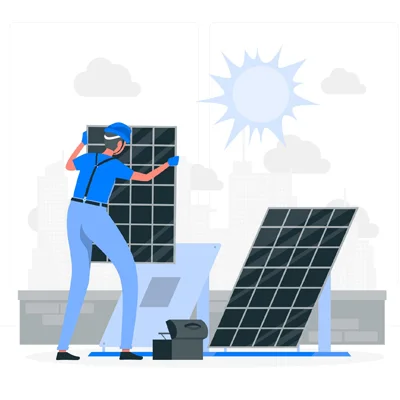Solar Energy: Redefining Power Dynamics for a Better World, refers to the radiant light and heat emitted by the Sun, which is harnessed and converted into usable forms of power. This renewable and sustainable energy source is crucial for life on Earth and can be utilized for various applications, including generating electricity, heating water, and powering various technological systems. The primary methods of harnessing solar energy include photovoltaic cells (solar panels), which convert sunlight into electricity, and solar thermal systems, which use sunlight to generate heat for applications such as heating water or producing steam for electricity generation. Solar energy is considered environmentally friendly, as it produces minimal pollution compared to traditional fossil fuel-based energy sources, making it a key component in the transition towards cleaner and more sustainable energy solutions.
History of Solar Energy
The history of solar energy dates back thousands of years, with humans harnessing the power of the sun for various purposes.
Here’s a brief overview of key milestones in the history of solar energy:
Ancient Use of Solar Power (Pre-19th Century):
- Ancient civilizations, such as the Greeks and Romans, used architectural techniques to capture and utilize solar energy for heating buildings.
The ancient Chinese also developed solar thermal technologies for heating water for domestic use.
Discovery of the Photovoltaic Effect (19th Century):
- In 1839, Alexandre Edmond Becquerel discovered the photovoltaic effect, which describes the generation of an electric current when certain materials are exposed to light. This laid the groundwork for the development of solar cells.
First Solar Cell (1888):
- The first true solar cell was built by American inventor Charles Fritts in 1888. Fritts coated selenium with a thin layer of gold to create a device that could convert light into electricity.
Einstein’s Photoelectric Effect (1905):
- Albert Einstein’s work on the photoelectric effect in 1905 provided further insights into the interaction between light and materials, contributing to the understanding of the underlying principles of photovoltaics.
Development of Solar Water Heaters (20th Century):
- In the early 20th century, solar water heaters gained popularity, particularly in warmer climates. These devices used sunlight to heat water for domestic use.
Space Exploration and Solar Technology (1950s-1960s):
- Solar technology saw significant advancements during the space race. Photovoltaic panels were used in satellites and space missions, such as the Vanguard 1 satellite in 1958.
Oil Crisis and Increased Interest (1970s):
- The oil crisis of the 1970s sparked renewed interest in alternative energy sources, including solar power. Governments and research institutions began investing in solar technologies.
Growth of Photovoltaic Industry (1980s-1990s):
- Advances in materials and manufacturing processes led to a growth in the photovoltaic industry. The development of thin-film solar cells and improvements in efficiency made solar energy more accessible.
Grid-Connected Solar Power (2000s-Present):
- The 21st century witnessed a significant increase in the deployment of grid-connected solar power systems for residential, commercial, and utility-scale applications. Government incentives and declining costs contributed to this growth.
Ongoing Innovations and Global Adoption (Present):
- Ongoing research and development continue to improve solar technologies, with a focus on increasing efficiency, reducing costs, and integrating solar power into the broader energy landscape. Solar energy plays a crucial role in global efforts to transition to cleaner and more sustainable energy sources.
The history of solar energy reflects a gradual evolution from ancient uses to modern technological advancements, positioning solar power as a vital component of the world’s energy future.

Types of Solar Energy
- Solar energy can be harnessed and utilized in various ways, and there are different types of solar technologies that enable the conversion of sunlight into useful forms of energy.
- Here are the main types of solar energy:
Photovoltaic Solar Power (PV):
- Description: Photovoltaic technology converts sunlight directly into electricity using semiconductor materials, typically silicon-based solar cells.
Applications: PV systems are widely used for residential, commercial, and utility-scale electricity generation. Solar panels on rooftops and solar farms are common applications.
Solar Thermal Power:
- Description: Solar thermal technologies use sunlight to generate heat, which is then used to produce steam to drive turbines connected to generators.
Applications: Solar thermal power plants are employed for large-scale electricity generation. There are two main types: concentrating solar power (CSP) and solar water heating systems.
Concentrating Solar Power (CSP):
- Description: CSP systems use mirrors or lenses to concentrate sunlight onto a small area, generating high temperatures. This heat is then used to produce steam and drive turbines.
Applications: CSP is used in large-scale power plants to generate electricity. There are various configurations, including parabolic troughs, solar power towers, and dish/engine systems.
Solar Water Heating:
- Description: Solar water heating systems capture sunlight to heat water for residential or industrial use. These systems typically include solar collectors and a heat exchanger.
Applications: Solar water heaters are used for domestic hot water in homes, as well as in industrial processes requiring heated water.
Passive Solar Heating and Cooling:
- Description: Passive solar design involves using building architecture and materials to capture and utilize sunlight for heating in the winter and shading for cooling in the summer without mechanical systems.
Applications: Passive solar design principles are integrated into the construction of buildings to optimize natural heating and cooling, reducing the need for conventional HVAC systems.
Solar Desalination:
- Description: Solar desalination uses solar energy to drive the desalination process, converting seawater into freshwater through methods such as solar stills or solar-assisted reverse osmosis.
Applications: This technology addresses water scarcity issues in regions with abundant sunlight and limited freshwater resources.
Solar-Powered Transportation:
- Description: Solar energy can be used to power vehicles, including solar cars, boats, and aircraft. Solar panels on the vehicle’s surface convert sunlight into electricity to drive electric motors or charge batteries.
Applications: Solar-powered transportation is still in the experimental and developmental stage but holds potential for sustainable mobility.
Solar-Powered Gadgets and Small Appliances:
- Description: Small-scale solar panels are used to power gadgets, outdoor lighting, and portable electronic devices.
Applications: These solar-powered devices are commonly used for camping, hiking, or as alternative power sources for off-grid applications.
These types of solar energy technologies collectively contribute to the utilization of sunlight for a wide range of applications, addressing electricity generation, heating, water desalination, and more. Ongoing advancements in solar technology continue to expand the possibilities and efficiency of solar energy systems.
Facts of Solar Energy
Certainly! Here are some key facts about solar energy:
Abundant and Renewable:
- Solar energy is an abundant and virtually inexhaustible source of renewable energy. The sun radiates an immense amount of energy, and harnessing even a small fraction of it could meet global energy needs.
Clean and Environmentally Friendly:
- Solar energy is a clean and environmentally friendly power source. It produces minimal air and water pollution, and its use helps reduce greenhouse gas emissions, contributing to the fight against climate change.
Reduced Electricity Bills:
- Installing solar panels on residential or commercial properties allows users to generate their own electricity, reducing dependence on grid power and potentially leading to lower electricity bills.
Low Operating and Maintenance Costs:
- Solar power systems generally have low operating and maintenance costs. Once installed, solar panels require minimal maintenance, and their operational life can span several decades.
Job Creation:
- The growing solar industry contributes to job creation. The manufacturing, installation, maintenance, and research associated with solar energy systems generate employment opportunities.
Grid Independence and Energy Security:
- Solar power systems, especially when coupled with energy storage solutions like batteries, can provide grid independence. This enhances energy security, reducing reliance on centralized power sources.
Off-Grid Power Solutions:
- Solar energy is ideal for providing power in remote or off-grid areas where traditional power infrastructure is unavailable or economically unfeasible. Solar-powered systems can be used for lighting, water pumping, and more.
Technological Advancements and Cost Reduction:
- Advances in solar technology and manufacturing processes have led to significant cost reductions. The price of solar panels has dropped dramatically over the past decade, making solar energy more accessible.
Net Metering Incentives:
- Many regions offer net metering programs, allowing solar system owners to sell excess electricity back to the grid, providing a financial incentive and encouraging the adoption of solar power.
Economic Benefits:
- The solar industry contributes to economic growth through investments, job creation, and the development of a sustainable energy infrastructure.
Scalability:
- Solar energy systems are scalable and can be adapted to various scales, from small residential installations to large utility-scale solar farms.
Solar Energy in Space Exploration:
- Solar power has played a crucial role in space exploration, providing a reliable source of energy for satellites, space probes, and the International Space Station (ISS).
Solar Energy Storage:
- Advances in energy storage technologies, such as batteries, complement solar power by enabling the storage of excess energy for use during periods of low sunlight or at night.
Global Growth and Investment:
- Solar energy has experienced significant global growth, with increasing investment in solar projects, research, and infrastructure across the world.
Educational and Awareness Opportunities:
- The adoption of solar energy provides educational opportunities for understanding renewable energy principles and encourages awareness of sustainable living practices.
These facts highlight the multifaceted benefits and potential of solar energy as a key component in the transition to a more sustainable and environmentally friendly energy landscape.
Benefits of Solar Energy
The adoption of solar energy offers a range of benefits, encompassing environmental, economic, and societal aspects.
Here are some key benefits of solar energy:
Clean and Renewable:
- Solar energy is a clean and renewable resource, producing electricity without emitting harmful pollutants or greenhouse gases. It helps reduce dependence on fossil fuels, mitigating environmental impacts.
Reduced Greenhouse Gas Emissions:
- Solar power contributes to the reduction of greenhouse gas emissions, which is crucial in addressing climate change. By generating electricity without burning fossil fuels, solar energy helps combat air pollution and its associated health risks.
Lower Electricity Bills:
- Solar panels on residential or commercial properties allow users to generate their own electricity, reducing reliance on grid power and potentially leading to lower electricity bills over time.
Low Operating Costs:
- Solar power systems generally have low operating costs once installed. They require minimal maintenance, and the fuel (sunlight) is free, providing a stable and predictable energy source.
Energy Independence:
- Solar power systems, especially when coupled with energy storage solutions like batteries, can provide energy independence. This reduces dependence on centralized power sources and enhances energy security.
Job Creation:
- The growing solar industry creates job opportunities in manufacturing, installation, maintenance, research, and related sectors. This contributes to economic growth and supports employment in various regions.
Incentive Programs:
- Many governments and utilities offer incentive programs, such as tax credits, rebates, and feed-in tariffs, to encourage the adoption of solar energy. These incentives can significantly reduce the upfront cost of installing solar systems.
Technological Advancements and Cost Reduction:
- Advances in solar technology and manufacturing processes have led to significant cost reductions. The declining cost of solar panels has made solar energy more economically viable for a broader range of consumers.
Grid Support and Stability:
- Distributed solar power systems contribute to grid stability by reducing the need for centralized power generation and transmission. They can also provide support during peak demand periods.
- Solar energy systems are scalable and adaptable to various scales, from small residential installations to large utility-scale solar farms. This flexibility allows for customized solutions based on energy needs.
Reduced Transmission Losses:
- Generating electricity close to where it’s consumed minimizes transmission and distribution losses associated with transporting electricity over long distances.
Resilience to Power Outages:
- Solar power systems with energy storage provide resilience during power outages. They can continue to supply electricity to critical loads, enhancing the reliability of the energy supply.
Land Use Efficiency:
- Solar installations can be integrated into existing infrastructure, such as rooftops and parking lots, minimizing the need for additional land. This helps preserve natural habitats and agricultural areas.
Community and Educational Opportunities:
- Solar projects and installations provide educational opportunities for communities to learn about renewable energy and sustainability practices, fostering environmental awareness.
Global Environmental Impact:
- The widespread adoption of solar energy on a global scale has the potential to make a substantial positive impact on the environment by reducing carbon emissions and slowing climate change.
These benefits collectively make solar energy an increasingly attractive and sustainable choice for individuals, businesses, and governments looking to transition to cleaner and more resilient energy systems.

Can solar save electricity?
Yes, solar energy can contribute to saving electricity, and in some cases, it can lead to a significant reduction in electricity costs.
Here are several ways in which solar energy can help save electricity:
On-Site Electricity Generation:
- Solar panels convert sunlight into electricity through photovoltaic technology. By installing solar panels on rooftops or in open spaces, individuals and businesses can generate their own electricity on-site, reducing the need to draw power from the grid.
Reduced Dependency on Grid Power:
- Solar power systems allow users to become less reliant on grid-supplied electricity. During daylight hours, solar panels generate electricity, which can be used directly by the property, stored in batteries for later use, or fed back into the grid.
Lower Electricity Bills:
- Generating your own electricity from solar panels can lead to lower electricity bills. Excess electricity generated during sunny periods can be credited or sold back to the grid in many regions, providing financial benefits.
Net Metering Programs:
- Net metering is a program in which solar system owners are credited for the excess electricity they feed into the grid. This credit can offset the electricity they consume from the grid during periods of low sunlight or at night. As a result, solar users may effectively pay less for the electricity they use.
Energy Storage Solutions:
- Solar power systems can be combined with energy storage solutions, such as batteries. Excess electricity generated during sunny periods can be stored for later use, enabling a continuous power supply during periods without sunlight.
Grid Support and Peak Shaving:
- Solar power systems can contribute to grid stability and support during peak demand periods. By generating electricity during peak hours, solar can help alleviate strain on the grid, reducing the need for additional power plants and infrastructure.
Reduced Transmission Losses:
- Generating electricity locally reduces the need for long-distance transmission and distribution of power. This can minimize transmission losses associated with transporting electricity over extensive power lines.
Environmentally Friendly Power Source:
- Solar energy is a clean and environmentally friendly power source. Choosing solar over traditional electricity sources reduces the environmental impact associated with electricity generation, helping to combat air pollution and reduce greenhouse gas emissions.
While the extent of electricity savings depends on factors such as the size of the solar installation, local sunlight conditions, and energy usage patterns, adopting solar energy can indeed lead to financial savings and a more sustainable approach to electricity consumption. It’s important to note that the economic viability of solar energy depends on various factors, including initial installation costs, available incentives, and the local cost of grid electricity.
How is solar energy stored?
Solar energy can be stored for later use through various energy storage technologies. Energy storage is crucial to ensure a continuous power supply when sunlight is not available, such as during nighttime or cloudy periods. Here are some common methods of storing solar energy:
Batteries:
- Description: Battery storage systems are one of the most common and widely used methods for storing solar energy. During periods of sunlight, excess electricity generated by solar panels is used to charge batteries. The stored energy can then be discharged when electricity demand exceeds the solar generation capacity.
Applications: Batteries are used in residential, commercial, and utility-scale solar installations. Popular battery technologies include lithium-ion batteries, lead-acid batteries, and flow batteries.
Pumped Hydro Storage:
- Description: Pumped hydro storage involves using excess electricity generated by solar panels to pump water from a lower reservoir to a higher one. During times of high electricity demand, the stored water is released to flow downhill, passing through turbines to generate electricity.
Applications: Pumped hydro storage is commonly used in large-scale energy storage systems. However, it requires specific geographic conditions, such as suitable elevation changes and available water resources.
Thermal Energy Storage:
- Description: Thermal energy storage systems store solar heat for later use. During periods of sunlight, solar thermal collectors capture and store heat, which can be used to generate steam for electricity production or for heating applications.
Applications: Thermal energy storage is often used in conjunction with concentrating solar power (CSP) systems, where mirrors or lenses concentrate sunlight to generate high temperatures for heat storage.
Flywheel Energy Storage:
- Description: Flywheel energy storage systems store kinetic energy by spinning a rotor at high speeds. When electricity is generated by solar panels, excess energy can be used to accelerate the flywheel. During periods of low solar generation, the flywheel is slowed down, releasing stored kinetic energy to generate electricity.
Applications: Flywheel energy storage is suitable for short-duration energy storage and is used in some grid-scale applications.
Compressed Air Energy Storage (CAES):
- Description: In compressed air energy storage, excess electricity is used to compress air and store it in underground caverns or containers. When electricity is needed, the compressed air is released, expanding and driving turbines to generate electricity.
Applications: CAES is a potential large-scale energy storage solution, but it requires suitable geological conditions for underground storage.
Hydrogen Production:
- Description: Solar energy can be used to produce hydrogen through a process called electrolysis, where water is split into hydrogen and oxygen. The generated hydrogen can be stored and later used in fuel cells to produce electricity.
Applications: Hydrogen storage is a versatile option that can be used in various applications, including transportation and industrial processes.
The choice of energy storage method depends on factors such as the scale of the solar installation, available space, cost considerations, and the intended use of the stored energy. Advancements in energy storage technologies continue to improve efficiency and cost-effectiveness, making solar energy more reliable and adaptable to different energy needs.





